Navigating the myriad of options for preventing heartworm, fleas, and intestinal worms in your beloved canine companion can be overwhelming. As dedicated experts in pet care, we understand the confusion many dog owners face. This comprehensive guide aims to clarify the choices available, presenting common, safe, and reputable treatments you’ll find at your veterinarian’s office or pet supplies store. Our goal is to empower you to make informed decisions for your dog’s optimal health, covering everything from powerful all-in-one solutions to specialized treatments. We’ll delve into the specifics of each product, helping you craft a tailored parasite prevention plan.
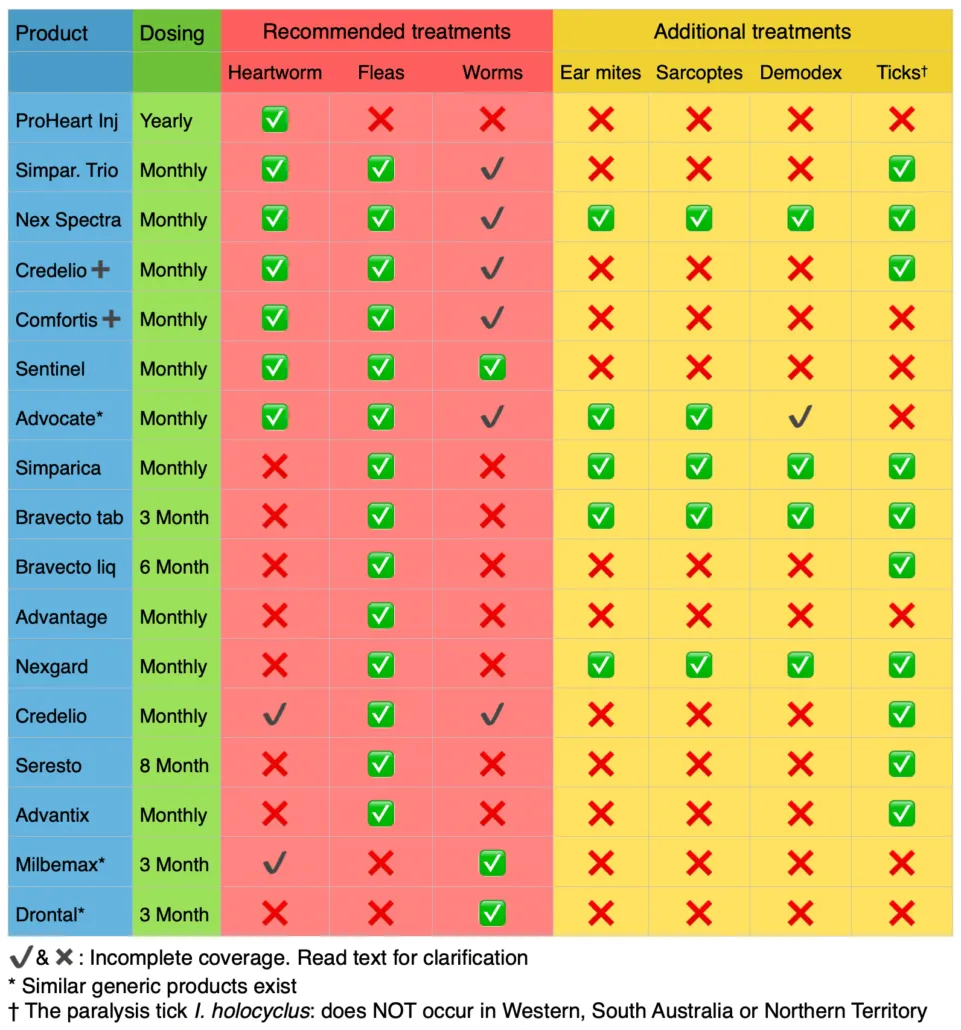 Comprehensive chart outlining various flea, heartworm, and intestinal worm treatments for dogs, detailing their protection scope
Comprehensive chart outlining various flea, heartworm, and intestinal worm treatments for dogs, detailing their protection scope
The chart above offers a quick overview of each product’s primary protections, with detailed descriptions provided below. Protection against parasites indicated in RED is generally considered essential for all dogs. While choosing a single product that covers the most issues seems straightforward, we advise a more personalized approach. Consult your veterinarian for advice specific to your pet before use. Remember to select products that avoid treating the same parasitic issue twice; for instance, if you choose a product that covers fleas, you won’t need an additional flea control product. Most quality flea, heartworm, and worming programs typically incur similar costs in the long run. For puppies, finding the right protection is crucial, and you can explore the best flea and worm treatment for puppies to ensure a healthy start.
Understanding Your Dog’s Parasite Protection Needs
Protecting your dog from parasites is a cornerstone of responsible pet ownership. Fleas, ticks, heartworms, and intestinal worms can cause a range of health issues, from mild irritation to life-threatening diseases. Understanding the risks in your specific region and your dog’s lifestyle will help determine the most effective prevention strategy. Always prioritize product safety, especially for certain breeds or medical conditions.
Important Note Regarding Tick Control
While tick prevention is crucial in many regions, some areas may have a low incidence of paralysis ticks. Always research the local parasite threats where you live or plan to travel. If you reside in or visit areas with a risk of paralysis ticks, consult your vet about the most effective prevention methods. Our guide on preventing tick paralysis can provide further insights.
1. All-in-One and Heartworm-Specific Preventatives
Heartworm is a severe, potentially fatal disease spread by mosquitoes. Prevention is much safer and more cost-effective than treatment. Monthly tablets or chews containing ivermectin (often found in supermarkets) should be used with extreme caution in Australian Shepherds, Collies, or Collie cross dogs due to a genetic sensitivity (MDR1 gene mutation). All dogs should be tested for heartworm before starting any new preventative, especially if there’s a chance they’ve missed previous doses.
Proheart® SR12 Once a Year Injection
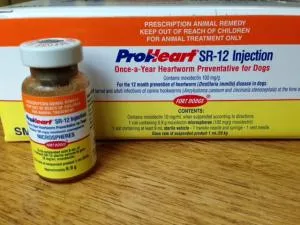 Veterinarian administering a Proheart SR12 annual injection to a dog for heartworm prevention
Veterinarian administering a Proheart SR12 annual injection to a dog for heartworm prevention
Prevents: Heartworm only (briefly active against hookworm).
Comes as: Annual injection (moxidectin).
- Often favored by pet owners for its convenience and reliability.
- Provides continuous, guaranteed protection against heartworm.
- Eliminates the need to remember monthly treatments.
- Safe for dogs who may have missed previous prevention doses.
- Can be used safely in breeding dogs, during pregnancy, and lactation.
- Many clinics offer reminders (email or SMS) when the injection is due.
Proheart SR12 offers long-term protection against heartworm. Dogs receiving this injection still require monthly flea control and intestinal worming tablets every three months. The primary benefit is the peace of mind that the most life-threatening parasitic disease is controlled with a single annual visit.
How to Use Proheart SR12:
It’s commonly recommended to start Proheart at 6 months of age, with subsequent injections timed around your dog’s annual vaccinations for a convenient single vet visit. However, it can be started at any time, and the annual schedule will follow from that date. While testing is advised, Proheart has been shown to be safe even if given to dogs carrying heartworm.
Simparica® Trio
Prevents: Heartworm, Fleas, Ticks, Intestinal worms (except tapeworm).
Comes as: A flavored chew given once every month (sarolaner, moxidectin & pyrantel).
- Offers highly effective flea and tick control, now with added heartworm prevention.
- Does not treat tapeworms, so additional tapeworm treatment may be required, especially for dogs with flea exposure or those that hunt.
- Convenient chewable form means no restrictions on bathing or messy topical application.
- Effective against paralysis ticks.
How to Use Simparica Trio:
Simparica Trio can be safely used in puppies from 8 weeks of age and dogs weighing over 1.25kg. Safety has not been thoroughly evaluated in pregnant, breeding, or lactating dogs, so consult your vet if your dog falls into these categories.
Nexgard® Spectra
Prevents: Heartworm, Fleas, Ticks, Intestinal worms (except tapeworm).
Comes as: A meaty chew given once every month (afoxolaner & milbemycin).
- Provides highly effective flea and tick control, combined with heartworm prevention.
- Also treats various mites, including those causing demodectic and sarcoptic mange, and ear mites.
- Does not treat tapeworms; regular intestinal wormers are still necessary.
- No restrictions on bathing or messy residue, thanks to its chewable format.
- Effective against paralysis ticks.
How to Use Nexgard Spectra:
Nexgard Spectra is suitable for puppies from 8 weeks of age and dogs over 2kg. It can be used in breeding, pregnant, and lactating females, though safety in breeding males has not been fully evaluated.
Credelio Plus®
Prevents: Fleas, Ticks, Heartworm, Intestinal worms (except tapeworm).
Comes as: A meaty chew given once every month (lotilaner, milbemycin).
- Comprehensive protection against heartworm disease.
- Highly effective for flea control.
- Effective against paralysis ticks.
- Convenient chewable form means no restrictions on bathing or messy application.
- Use with caution in dogs with a history of seizures.
How to Use Credelio Plus:
Credelio Plus can be administered to dogs from 8 weeks of age and over 1.4 kg body weight. Safety data for pregnant, breeding, or lactating dogs is limited, so vet consultation is advised.
Comfortis® Plus (previously Panoramis)
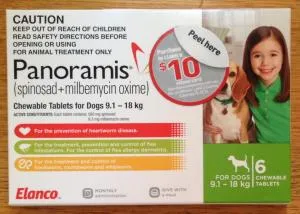 Comfortis Plus (Panoramis) packaging for dogs, indicating its use for flea and heartworm prevention
Comfortis Plus (Panoramis) packaging for dogs, indicating its use for flea and heartworm prevention
Prevents: Heartworm, Fleas, Intestinal worms (except tapeworm).
Comes as: A tablet, given monthly with food (spinosad & milbemycin).
- Offers highly effective control of fleas and heartworm.
- Oral tablet ensures no issues with bathing or topical residue.
- It’s generally advised to supplement with a tapewormer every 6 months.
- Not recommended for Collies or Australian Shepherds due to potential sensitivities.
For dogs that find tablets difficult to take, alternative topical treatments might be preferred. If monthly dosing compliance is a concern, an annual injectable heartworm preventative combined with separate flea and intestinal worm treatments could be a better option.
How to Use Comfortis Plus:
Comfortis Plus can be used from 14 weeks of age. There’s a serious interaction risk with off-label doses of ivermectin, so always inform your veterinarian if your dog is on Comfortis Plus, especially if treatment for mites is needed. Dogs potentially carrying heartworm should be tested before starting this medication. Safety in breeding, pregnant, and lactating animals has not been established.
Sentinel®
Prevents: Heartworm, Fleas (sterilizes), Intestinal worms (all major types including tapeworm).
Comes as: A tablet, given monthly with food (milbemycin, lufenuron & praziquantel).
- No restrictions on bathing or messy topical application.
- Safe for use in very young animals.
Disadvantages include the necessity of administering a potentially large tablet monthly and the discipline required to remember doses. The flea control mechanism sterilizes fleas rather than killing adult fleas outright, meaning dogs in heavily flea-infested environments might still encounter live fleas and require supplementary treatments to manage outbreaks. Sentinel is considered safe during pregnancy and lactation.
How to Use Sentinel:
Sentinel is safe for puppies from 6 weeks of age and for breeding dogs. Dogs with a missed prevention history should be blood-tested for heartworm before starting Sentinel.
Advocate®
Prevents: Heartworm, Fleas, some intestinal worms, most mites.
Comes as: A vial of liquid applied to the back of the neck monthly (moxidectin & imidacloprid).
- Provides rapid flea control.
- Effective against heartworm and fleas, and also useful for treating ear mites in puppies and dogs exposed to sarcoptic mange (fox mange).
- Aids in the control of demodectic mange.
- If you’re wondering about the best way to treat ear mites in dogs, Advocate offers effective treatment.
How to Use Advocate:
Advocate can be used from 7 weeks of age. Dogs can be bathed after 48 hours, but frequent bathing may reduce flea control efficacy. The solvent can damage clothing and painted surfaces, so apply with care and prevent licking. Some dogs may experience coat color changes at the application site. Heartworm testing is recommended for dogs with lapsed prevention before starting Advocate. Safety in pregnancy has not been established.
Revolution® (discontinued)
Prevents: Heartworm, Fleas, Intestinal worms (some types), some mites.
Comes as: A vial of liquid applied to the back of the neck monthly (selamectin).
- Update 2020: Selapro® and Evicto® are currently available equivalent products, though they typically do not include intestinal worming.
- A quick-drying, less messy spot-on treatment.
- Once fully absorbed, bathing will not diminish its effectiveness.
- Effective against heartworm and fleas, and also beneficial for treating ear mites in puppies and dogs exposed to sarcoptic mange.
- A popular choice for combined flea and heartworm prevention.
- Safe for very young animals.
- No adverse effects reported in trials involving breeding, pregnant, or lactating dogs. For more information on dealing with mites, consider exploring home remedies for ear mites in cats and dogs.
How to Use Revolution (and equivalents):
Revolution can be safely applied to puppies from 6 weeks of age. Heartworm testing is required for dogs with missed prevention. You will still need to use an intestinal worming treatment. (Previously, Canex intestinal all-wormer was supplied with 6-packs of Revolution).
2. Flea & Tick Preventatives (Without Heartworm)
These products are designed to be used in conjunction with a separate heartworm preventative and regular intestinal worming. For effective flea control, all cats and dogs within a household must be treated simultaneously. Systemic (tablet) treatments are often considered more environmentally friendly than topical (spot-on) options. Warning: Never use products formulated for dogs on cats, rabbits, or ferrets, as they can be highly toxic.
Simparica®
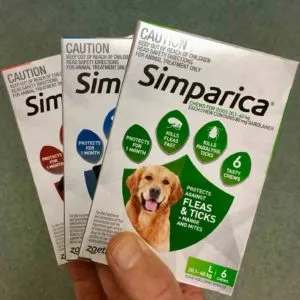 Simparica chewable tablet packaging for dogs, used for flea, mite, and tick prevention
Simparica chewable tablet packaging for dogs, used for flea, mite, and tick prevention
Prevents: Fleas, mites, ticks.
Comes as: A tablet given once every month (sarolaner).
- Provides highly effective flea control.
- Oral tablet means no restrictions on bathing or messy residue.
- Registered for the treatment of demodectic mange.
- Also treats sarcoptic mange and ear mites.
- Effective against paralysis ticks.
How to Use Simparica:
Simparica can be used from 8 weeks of age in puppies and dogs weighing over 1.3kg. Safety has not been evaluated in breeding, pregnant, or lactating dogs.
Bravecto®
Prevents: Fleas, ticks.
Bravecto (fluralaner) comes in two forms:
- A chewable tablet given once every 3 months with food.
- A spot-on pipette given every 6 months.
- Offers very long-acting flea control.
- Controls paralysis ticks for 4 months (chew) or 6 months (spot-on).
- Suitable for dogs up to 56kg.
- The chewable form (but not the spot-on) also treats demodectic and sarcoptic mange, and ear mites.
- Safe for use in breeding, pregnant, and lactating animals.
How to Use Bravecto:
Bravecto can be used from 8 weeks of age in dogs weighing 2kg or more. However, for very young puppies, significant body weight changes can make accurate dosing challenging for such a long-acting product. We typically recommend starting it at or after 6 months of age. Always administer with a meal.
Advantage®
Prevents: Fleas.
Comes as: A vial of liquid applied to the back of the neck monthly (imidacloprid).
- Provides fast, effective flea control.
- Known for nearly two decades of reliable performance.
- Offers a wide dose range, convenient for multi-animal households.
- Safe for use during pregnancy and lactation.
How to Use Advantage:
Advantage can be used from weaning. Treating the mother will also provide protection for puppies before weaning. Animals can be bathed after 48 hours, but frequent bathing may reduce flea control efficacy. The solvent can damage clothing and painted surfaces, so apply with care and prevent licking.
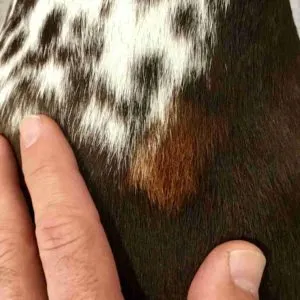 Close-up of a dog's fur showing permanent hair color change at the site of topical flea treatment applicationThe image above shows a permanent hair color change that occurred at the application site in one dog, illustrating a potential cosmetic side effect.
Close-up of a dog's fur showing permanent hair color change at the site of topical flea treatment applicationThe image above shows a permanent hair color change that occurred at the application site in one dog, illustrating a potential cosmetic side effect.
Nexgard®
Prevents: Fleas, Ticks.
Comes as: A meaty chew given once every month (afoxolaner).
- Offers highly effective flea control.
- Oral chewable form means no restrictions on bathing or messy residue.
- Effective against paralysis ticks.
- Use with caution in dogs with a history of seizures.
How to Use Nexgard:
Nexgard can be used from 8 weeks of age in animals over 2kg. It can be used in breeding, pregnant, and lactating females, though safety in breeding males has not been fully evaluated.
Credelio®
Prevents: Fleas, Ticks.
Comes as: A meaty chew given once every month (lotilaner).
- Provides highly effective flea control.
- Oral chewable form means no restrictions on bathing or messy residue.
- Effective against paralysis ticks.
- Use with caution in dogs with a history of seizures.
How to Use Credelio:
Credelio can be used from 8 weeks of age in animals weighing over 1.3 kg. Safety has not been evaluated in pregnant, breeding, or lactating dogs.
Seresto®
Prevents: Fleas & Ticks.
Comes as: An insecticide-impregnated collar (imidacloprid & flumethrin).
- Offers continuous flea control for up to 8 months and tick control for up to 4 months.
How to Use Seresto:
Seresto can be used from 7 weeks of age. Safety in pregnancy has not been established.
Advantix®
Prevents: Fleas & Ticks.
Comes as: A vial of liquid applied to the back of the neck monthly (imidacloprid & permethrin).
- Provides flea control for 1 month and tick prevention for 2 weeks.
- Highly toxic to cats—extreme caution must be exercised in multi-pet households.
- May offer unique fly and mosquito repellent effects.
- Safe for use on pregnant and lactating bitches.
How to Use Advantix:
Advantix can be used from 7 weeks of age.
3. Products to Treat Intestinal Worms
There are four primary intestinal worms to be aware of: roundworm, hookworm, whipworm, and tapeworm. Understanding their life cycles and symptoms is crucial for effective treatment. Many effective wormers are available, and most perform reasonably well. Look for products containing two or more active ingredients, including at least ‘praziquantel’ plus one other, to ensure broad-spectrum coverage. Always worm all adult dogs in a household simultaneously.
The recommended worming schedule is every two weeks until 12 weeks of age, then monthly until 6 months old, and subsequently every three months for life. In areas with a high risk of hydatid tapeworm (typically rural regions), worming every 6 weeks may be necessary. If you are concerned about specific treatments, you can research over the counter hookworm medicine for dogs or potential side effects of hookworm medicine for dogs.
Milpro®, Milbemax® etc.
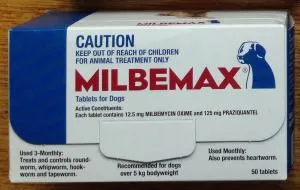 Milbemax dog wormer packaging, illustrating its use for treating intestinal worms in dogs
Milbemax dog wormer packaging, illustrating its use for treating intestinal worms in dogs
Prevents: Intestinal worms.
Comes as: Tablet (milbemycin & praziquantel).
- Small tablets that are often easily hidden in food.
- A single tablet typically treats dogs up to 25kg.
- Highly effective for comprehensive intestinal worming.
- Can also be used for heartworm control if administered monthly.
How to Use Milpro (and similar products):
Follow the schedule listed above. Do not use in dogs who may have heartworm without prior blood testing. Safe for use in pregnant bitches.
Drontal®
Prevents: Intestinal worms.
Comes as: Tablet, drops, flavored chews (various formulations).
- An original and widely trusted brand name all-wormer.
- Provides highly effective intestinal worming.
- Many generic formulations with similar active ingredients exist.
How to Use Drontal:
Follow the recommended worming schedule outlined above. Drontal is safe for use during pregnancy.
Conclusion
Choosing the Best Flea And Worm Treatment For Dogs is a vital part of proactive pet care. With numerous effective options available, from convenient all-in-one monthly chews to specialized annual injections and topical solutions, finding the right regimen depends on your dog’s lifestyle, breed considerations, your geographical location, and your personal preferences for administration. Always consult with your veterinarian to discuss your dog’s specific needs and to create a tailored parasite prevention plan that ensures their continued health and well-being. Regular veterinary check-ups are also crucial to monitor your dog’s health and adapt their treatment plan as needed. For more insights into comprehensive pet health, explore other articles on Dog Care Story!
